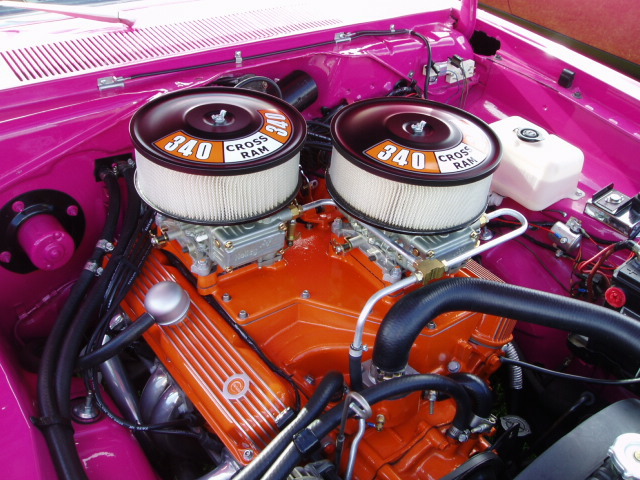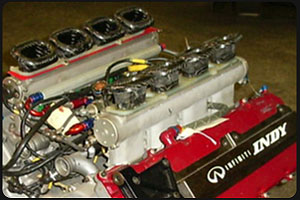
tuna55
MegaDork
6/22/20 11:43 a.m.
Personally I think unless it's a flathead, most of the aesthetic comes from the induction system. You could, for instance, get an LS2 and put the faux big block valve covers on it and a carb dual four barrel intake and say it's a 396 and 95% of the people would buy it.
My vote would be the GMC V12 or V6 for sheer audacity.



tuna55
MegaDork
6/22/20 11:45 a.m.
For reference, this is a gen III V8. It could be a 4.8 or a rip roarin LS3 or better.


tuna55
MegaDork
6/22/20 11:47 a.m.
One more honorable mention from me based on looks alone:


Pattyo
Reader
6/22/20 1:52 p.m.
In reply to tuna55 :
Good lord, those v12s look like train engines! Love it!
In reply to tuna55 :
If you're going crossram at least go big. Sonoramic Commando with the carbs hanging out past the edges of the body work


Pattyo said:
Frenchy, I would never look at dealerships for a parts car. I looked at CL, offerup, FB marketplace. This morning i expanded my search to the max. distance and still came up empty handed for any v12s with carbs- not to mention manual trans.
It did lead me to an estate sale that seems to have a lot of engines in bare chassis though so i might go check that out.
I love the look of the nailhead and I'll have to keep my eyes open for them. Maybe when things settle down and swap meets start up again I'll be able to talk tp the old timers and see what they have stashed away.
I think the beauty of the corvair engine comes from taking simplicity - no radiator or hoses and you could do a wild grill. I would want to de-tin it and try to expose as much of the cooling fins as possible. Probably have to throw the fan underneath so she wouldn't get too hot idleing.
1971-74 V12's were in the XKE and most were 4 speed manuals. They all had carbs. In 1972 a few wound up in the 4 door sedan, they were all Automatic. In 73-76 a few V12's wound up in the 2 door sedan and only a couple weren't automatics. 1974 was the last year for carbs. The 4 door sedan with V12's were all automatics. In 1975 the XJS was introduced with fuel injection only 12 were produced with 4 speed manuals. In mid -1977 the GM Turbo 400 was introduced replacing the Borg Warner auto
That's when it got real easy to swap to a manual transmission. Either case unless you find the rare Jaguar 4 speed manual transmission you will need to make an adapter plate. Depending on what transmission you use you will need either 7/8" or 1 inch plate. It takes me about a morning to drill and tap one and then on my band saw it's about 30 minutes to cut away the excess. The first one I did I used my old saber saw and that probably took more than an hour.
The early ones ( pre mid 1977 ) it will take you additional time to locate the smaller locating dowels. Enough time that if I want a manual conversion I'll just use the later engines.
After 1980 the compression went from 7.8-1 to 11.5-1
Now you can retro fit the carbs on any engine. It will cost you 20 horsepower ( but it's still more than the 454 Chevy ) and you gas mileage will be worse. Driven nicely the V12 with fuel injector in the 4665 pound XJS will get in the high teens while the the same car with carbs will get in the low teens
Since the whole engine is aluminum if you're willing to do the work it can be polished up like chrome. Awesome look. But that's a lot to polish. One hint, once you're done with all the smoothing and doing the final bit with aluminum polish use regular flour to remove the black residue. A few cups of cooking flour will save you a lot of polishing time. Just give it a light dusting and the black residue just wipes off.

Realize that some of those years due to labor issues very few Jaguars were made.For instance only 996 Jaguar XJS were made in 1976 and not a lot more sedans. In 1979 only 1312 XJS's were made, but about 3 times that in Sedans. Starting in 1981 production of just the XJS went over 3000 a year and climbed steadily until end of production in 1997. Although by the 1990's the six cylinder version cut into engine production.. The sedan always exceeded the XJS by a large amount. But that was split between V12's and Six cylinders.
In reply to frenchyd :
This is what a carb manifold looks like ( there are 4 per engine )
length wise the engine is 32 inches to the bell housing from the front of the water pump pulley. If you aren't using the stupid, ugly, heavy, air conditioning, or want to mount a little one to the side you can cut off 2 or 3 of the pulley grooves to shorten it.
It is only 22 inches wide to the outside of the exhaust manifolds.
From the bottom of the pan To the top of the intake manifold is only 25" high but the throttle bell crank it's taller, maybe another inch or so


Honsch
New Reader
6/22/20 7:52 p.m.
I know where you can get one of these:


Pattyo
Reader
6/22/20 10:23 p.m.
In reply to Honsch :
That thing is amazing... Tell me more.

Honsch
New Reader
6/23/20 1:37 a.m.
Pattyo said:
In reply to Honsch :
That thing is amazing... Tell me more.
Specialty Engineering in Delta BC bought some or all of the old Infiniti engines when they got out of Indy car racing. I have no idea how much he wants for one, but there you go. The guy is an artisan who builds race cars. Amazing work.
Visual interest? How about a Pratt & Whitney Wasp R-1340? Exposed pushrod tubes, air-cooled goodness. Packaging may be a challenge.

Since power isn't the issue and you are after a unique look...

This could be done to your SBF.....
If you're going to run the intake charge through the exhaust ports like that, might as well drive an 8-71 blower straight off the crank snout going forward from the engine and then duct the boost to the motor using pipework. What's a couple hundred hours with a tig welder and bandsaw?
Mr_Asa said:
MrChaos said:
im a fan of a straight 6 hot rod, triple webbers or 6 single carbs
This.
Few things look better, to my mind.
The 300ci Ford I6 is real easy to do triple 1bbls, you just get three of the same 1bbl intake and chop the external cylinders off.
http://www.inliners.org/Koesel3x1.htm

I know it's a zombie thread but, if I had to pick only one gas engine to have in a fleet of cars I'd pick the 300 I6, maybe I'm just crazy like that.
Great truck engine, probably decent car engine if you swap it in, people have made them fast, it's in dump trucks, and even generators. Plus i6s just have something I like a whole bunch about them.
Sure a 300 I6 chainsaw would be challenging, and don't get me started on the weed wacker model, but living the La Vida 300 I6 would be the level of crazy id probably do












































